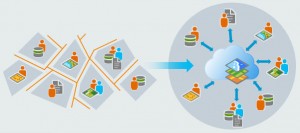- Home
- :
- All Communities
- :
- Services
- :
- Esri Training
- :
- Esri Training Matters Blog
- :
- Three Tips for GIS Content Sharing
Three Tips for GIS Content Sharing
- Subscribe to RSS Feed
- Mark as New
- Mark as Read
- Bookmark
- Subscribe
- Printer Friendly Page
Updated January 16, 2017
Given that technology—the Internet, e-commerce, smartphones, the behemoth that is social media—has dramatically changed consumer and personal behavior over the last decade, it's no surprise our professional lives have evolved. For many of us, what we do at work and how we do our work have changed a great deal.
At the same time, more and more organizational leaders have grasped the business value of getting geospatial content out of a department silo and into the hands of knowledge workers using ArcGIS Online or ArcGIS Enterprise and a variety of enterprise applications.

As a result, many GIS professionals are being asked to share. Of course, the profession as a whole is a generous lot, so sharing itself is nothing new. What's new is the ease with which things can be shared.
The ArcGIS portal has become an integrated content platform that supports enterprise GIS workflows and the information needs of both GIS and non-GIS professionals, collaborative working groups, and the public.
When there are many potential content consumers, the question of what to share needs to be carefully considered. If you're in the process of crafting a sharing strategy for your ArcGIS portal (an ArcGIS Online organizational site or an ArcGIS Enterprise portal website), here are three tips to help the process along.
1. Prioritize Consumer Relevance
While you could share all types of geospatial content, that may not be feasible or desirable. When faced with an overwhelming number of choices, site users may opt out. Feature the content that your organization's users are most likely to be interested in.
Like you, site users will be most interested in content that helps them do their work faster, easier, and better. Think about your organization's structure (or constituents) and imagine you're a content consumer. Why have you come to this site? What are you hoping to do with the content you find?
For an analyst with the market research group, maps showing customer and physical business locations, demographic data, and drive times might be highly desirable. Templates for branded web apps could also be useful.
Make a list of frequently requested items. How many times does your team create the same or very similar information products for different groups? Share that content.
If you've ever thought to yourself, "If the folks in [department X] only knew how our data could help them!" Well, now's your chance to showcase your data to school the non-GIS teams on the value that geographic insight brings to their projects.
Once you've settled on what to share, decide how to share it. It may make sense to create hosted feature layers for data that will be especially popular.
2. Provide Guide Posts
Never underestimate the power of clear directions. Think about your favorite e-commerce sites. How do they direct you to products? Their home pages likely have prominent links to:
- The latest products
- The five or ten most popular products
- Recommended items for specific use cases ("Dorm essentials for your new college student!")
Adopt these familiar methods to enhance your ArcGIS Online organization's or enterprise portal's home page, your front door if you will. A front door should be welcoming, but quickly passed through. You want visitors to enter the living space and join the party.
The home page description section is a great (visible) place to add links that will guide users to the relevant content you've shared.
3. Teach Them to Fish
Who better to help the masses create accurate, impactful maps and apps than a GIS professional? Your ArcGIS Online organization is a rich source of authoritative content However, a lot of people may not know exactly how to use it at first.
You can help content consumers get up to speed by adding frequently asked questions and tips from the GIS team on your organizational site. Of course, you should always document essential information in the item properties, including:
- Who created the data and when?
- What is the data's accuracy?
- Explanation of numeric attributes shown in a map legend or table (unless the data is clearly unambiguous)
- Access and use constraints
Here's a good example of item properties for a web map. To make sure consumers see this information, you can get creative. The Open Data DC app effectively provides key information about the app right inside the app.
As you're documenting your content, support searching, which is how people find things these days. Create a set of standard tags—both geographical and topical—and consistently apply them.
By sharing relevant content and helping consumers understand how the content can be used to shed new light on their work, you extend the benefits of GIS well beyond its current boundaries. Ladies and gentlemen, we have reached the point where the work produced by GIS professionals is being widely viewed as a strategic organizational asset. Carpe diem.
Related training:
Is your team just getting started with an ArcGIS Online organizational site? These courses are designed to help administrators, content producers, and content consumers be productive right away.
You must be a registered user to add a comment. If you've already registered, sign in. Otherwise, register and sign in.
-
ArcGIS Desktop
26 -
ArcGIS Step by Step
46 -
Class Resources
18 -
e-Learning
62 -
MOOCs
28 -
Software Demos
10 -
Technical Certification
16